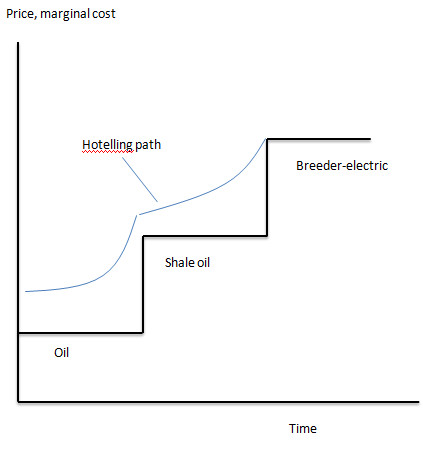
I'm not sure this is the best time to be having this debate (a once in a millennium disaster tends to interfere with the ability to accurately evaluate risks), but Paul Krugman has a good post on the subject:
As Nordhaus’s RA, I spent the summer of 1973 on this project: my days were spent in the geology library, reading Bureau of Mines circulars on the engineering and costs of alternative energy sources, my nights at the computer center drinking vending machine coffee. (These were still the days of big mainframes and punchcards; you handed a deck of cards to the high priests behind the glass wall, then an hour later you got back a huge stack of hexadecimal garbage because you made an error on one of your cards.)
In short, I was in heaven.
Nordhaus’s paper was wonderful. (Sorry, for technical reasons I can’t put up a full version from my current undisclosed location.) But as it turned out, it was much too optimistic. Not his fault or mine: it was those Bureau of Mines circulars.
What was wrong with those circulars? They were much too optimistic about the costs of alternative energy sources, especially alternatives to oil. Basically, the engineers were understating the difficulties involved. Later Marty Weitzman would formulate a law on this: the cost of alternatives to crude oil is 40% above the current price — whatever the current price is.
And hence my skeptical reaction to the new study about the costs of running an all-renewable economy.
To be fair, we probably have much more solid ideas about the cost of wind and solar power than we did about shale oil and coal liquefaction back in 1973: wind is already a widely used technology, and concentrated solar power — probably the main way we’ll use the sun — is pretty well understood too. But there will be surprises, not all of them positive.
None of this is meant to disparage the work, or the need to use much more renewables than we are using now.
"a once in a millennium disaster"
ReplyDeleteWell, the Cascadia fault has an incident every 3 to 5 hundred years and there tend to be of greater than 9 in magnitude. So we'd expect between 2 and 3 worth incident per millennium.
But I would agree that once per century is accurate and that this inflates our perception of the risk of nuclear power. That being said perhaps the risk/benefit ratio needs to be double checked for the Pacific Ring of Fire (as it could be generated elsewhere and transmitted).
"A thrice in a millennium disaster" doesn't really roll off the tongue.
ReplyDeleteTrue. :-)
ReplyDeleteBut for me this is really a case of placement. Northern California, Chile, Washington State, Japan . . . these are all places where it might not be as ideal to have nuclear power. But we should be able to either transmit power there or substitute with plants elsewhere (in more geologically stable places). It's just like hydroelectricity: some regions are more able to make use of it than others.